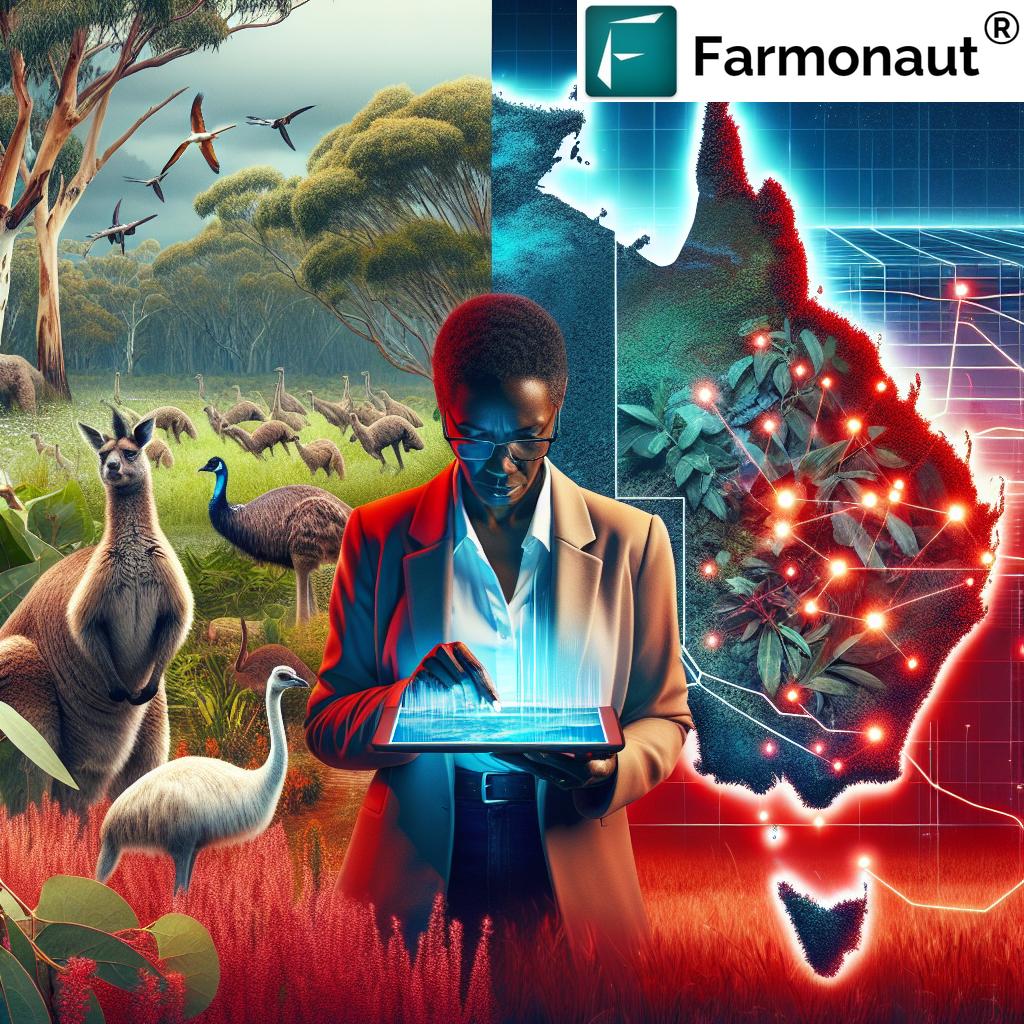Australia’s Biosecurity Shield: Safeguarding Agriculture and Environment Through National Awareness and Innovation
“Australia’s inaugural National Biosecurity Week involved stakeholders from 65% of the country’s agricultural sectors.”
In the vast landscape of Australia, where the rugged Outback meets thriving agricultural regions, a silent guardian stands watch – our nation’s biosecurity shield. As we delve into the critical importance of biosecurity measures in safeguarding Australia’s agricultural industry and environment, we find ourselves at the forefront of a new era in plant health protection and agricultural pest management.
The inaugural National Biosecurity Week recently highlighted Australia’s unique position in defending its borders against invasive species, crop diseases, and other biological threats. This landmark event brought together farmers, scientists, policymakers, and innovators to raise awareness about the critical role of biosecurity in preserving our nation’s economic and environmental well-being.
The Importance of National Biosecurity Awareness
Australia’s geographic isolation has long been our first line of defense against external biological threats. However, with increasing global trade and the looming specter of climate change, our biosecurity challenges are evolving rapidly. The National Biosecurity Week served as a clarion call, emphasizing the collective responsibility we all share in maintaining Australia’s biosecurity.
- Protecting $65 billion worth of agricultural exports
- Safeguarding unique ecosystems and biodiversity
- Ensuring food security for millions of Australians
- Maintaining our reputation as a producer of clean, green agricultural products
As we navigate these challenges, innovative technologies are playing an increasingly vital role in our biosecurity efforts. One such technology that’s revolutionizing the field is remote sensing, offered by companies like Farmonaut. Their advanced satellite-based farm management solutions provide early detection of pest infestations and crop health issues, bolstering our first line of defense against potential biosecurity threats.

The Pillars of Australia’s Biosecurity Strategy
Australia’s approach to biosecurity is multifaceted, combining stringent regulations, cutting-edge technology, and community engagement. Let’s explore the key pillars that form the foundation of our national biosecurity strategy:
- Pre-border measures: Rigorous import regulations and risk assessments
- Border control: Stringent quarantine procedures and inspections
- Post-border surveillance: Continuous monitoring and rapid response systems
- Community engagement: Public awareness campaigns and citizen science initiatives
- Research and innovation: Ongoing scientific studies and technological advancements
Each of these pillars plays a crucial role in maintaining Australia’s biosecurity shield. However, it’s the synergy between them that truly sets our approach apart on the global stage.
Innovative Approaches to Biosecurity Challenges
As we confront evolving biosecurity threats, Australia is embracing innovative solutions to detect, prevent, and respond to potential emergencies. Here are some cutting-edge approaches that were highlighted during the National Biosecurity Week:
- AI-powered pest identification: Machine learning algorithms that can quickly identify and categorize potential invasive species
- Environmental DNA (eDNA) sampling: Advanced techniques to detect the presence of invasive aquatic species through water samples
- Drone surveillance: Unmanned aerial vehicles equipped with high-resolution cameras for monitoring remote areas
- Blockchain traceability: Secure, tamper-proof systems for tracking the movement of agricultural products
- Satellite-based crop monitoring: Remote sensing technology for early detection of crop health issues and potential pest infestations
Speaking of satellite-based crop monitoring, it’s worth noting that Farmonaut’s remote sensing technology can detect crop health issues up to 14 days earlier than traditional methods. This early warning system is proving invaluable in our fight against potential biosecurity threats.
The video above demonstrates how Farmonaut’s satellite technology is revolutionizing land use in agriculture, providing valuable insights for biosecurity efforts.
The Role of Remote Sensing in Biosecurity
Remote sensing technology, such as that offered by Farmonaut, is playing an increasingly crucial role in Australia’s biosecurity efforts. By providing real-time, high-resolution data on crop health and land use changes, these technologies offer several advantages:
- Early detection of pest infestations and crop diseases
- Monitoring of vegetation changes that could indicate the spread of invasive plant species
- Tracking of land use changes that might impact biodiversity
- Assisting in the planning and execution of targeted biosecurity interventions
Farmonaut’s platform goes beyond simple imaging, integrating artificial intelligence and machine learning to provide actionable insights for farmers and biosecurity professionals alike. By leveraging these advanced technologies, we’re able to create a more robust and responsive biosecurity shield for Australia.
Biosecurity in Agriculture: Protecting Our Economic Backbone
Agriculture is the lifeblood of many Australian communities and a significant contributor to our national economy. The importance of biosecurity in agriculture cannot be overstated. Let’s explore some key areas where biosecurity measures are crucial:
- Crop Protection: Safeguarding against invasive pests and diseases that could decimate harvests
- Livestock Health: Preventing the spread of animal diseases that could impact meat and dairy production
- Export Market Access: Maintaining Australia’s reputation for clean, disease-free agricultural products
- Sustainable Farming Practices: Promoting methods that enhance natural pest resistance and reduce reliance on chemical interventions
During the National Biosecurity Week, we saw numerous examples of how innovative technologies are being applied to these challenges. For instance, Farmonaut’s satellite-based crop monitoring system is helping farmers detect potential issues early, allowing for targeted interventions that minimize the use of pesticides and reduce the risk of disease spread.

Environmental Biosecurity: Protecting Our Unique Ecosystems
Australia’s biodiversity is not just a source of national pride; it’s a crucial component of our ecological and economic well-being. Environmental biosecurity focuses on protecting our native flora and fauna from invasive species and diseases. Some key aspects include:
- Preserving native habitats and ecosystems
- Controlling the spread of invasive plant and animal species
- Protecting endangered species from new threats
- Maintaining the health of our marine environments
Advanced technologies are proving invaluable in these efforts. For example, Farmonaut’s remote sensing capabilities can be used to monitor changes in vegetation patterns, potentially indicating the spread of invasive plant species or the impact of climate change on native ecosystems.
The video above showcases Farmonaut’s advanced agri solutions, including precision crop area estimation, which can be invaluable for monitoring and managing agricultural land use in environmentally sensitive areas.
The Economic Impact of Biosecurity Measures
Investing in biosecurity is not just about protecting our environment and agriculture; it’s a sound economic strategy. The costs of preventing biosecurity breaches are far outweighed by the potential economic losses from pest and disease incursions. Consider these facts:
- Australia’s agricultural exports are worth over $65 billion annually
- A single outbreak of foot-and-mouth disease could cost the Australian economy up to $52 billion over 10 years
- The cost of managing established invasive species is estimated at $13.6 billion per year
By investing in innovative biosecurity measures, including technologies like Farmonaut’s remote sensing platform, we’re not just protecting our current economic interests – we’re safeguarding Australia’s future prosperity.
Explore Farmonaut’s API for advanced agricultural data
Training and Capacity Building in Biosecurity
A key focus of the National Biosecurity Week was on training and capacity building. Ensuring that we have a skilled workforce capable of implementing and maintaining our biosecurity measures is crucial. Some key initiatives include:
- Specialized training programs for biosecurity officers
- Workshops for farmers on best practices in pest management
- Public awareness campaigns to educate the community about biosecurity risks
- Collaboration with universities to develop cutting-edge biosecurity research programs
Technology plays a vital role in these training efforts. For instance, Farmonaut’s platform can be used as an educational tool, helping farmers and biosecurity professionals understand how to interpret satellite data for early pest detection and crop health monitoring.
The video above demonstrates how to generate time-lapse imagery using Farmonaut’s platform, a valuable tool for tracking changes in land use and vegetation health over time.
Partnerships and Collaboration in Biosecurity
Effective biosecurity requires a collaborative approach, bringing together government agencies, research institutions, private sector innovators, and community groups. The National Biosecurity Week highlighted several successful partnerships, including:
- Joint research initiatives between universities and government departments
- Public-private partnerships for developing new biosecurity technologies
- Community engagement programs involving local environmental groups
- International collaborations for sharing best practices and research findings
These partnerships are essential for developing comprehensive, innovative approaches to biosecurity challenges. They allow for the sharing of knowledge, resources, and expertise, leading to more effective and efficient biosecurity measures.
Check out Farmonaut’s API Developer Docs for integration possibilities
The Future of Biosecurity in Australia
As we look to the future, it’s clear that biosecurity will continue to be a top priority for Australia. The challenges we face are evolving, but so too are our capabilities to meet them. Some key areas of focus for the future include:
- Further integration of AI and machine learning in biosecurity systems
- Development of more sophisticated predictive models for pest and disease outbreaks
- Expansion of remote sensing capabilities for environmental monitoring
- Enhanced international cooperation on biosecurity issues
- Continued investment in research and innovation
Technologies like those offered by Farmonaut will play an increasingly important role in this future. By providing real-time, actionable data on crop health and land use changes, these tools will form a crucial part of Australia’s biosecurity infrastructure.
The video above showcases how Farmonaut is making farming better with satellite data, a technology that’s set to play a crucial role in the future of biosecurity.
Key Biosecurity Threats and Innovative Solutions in Australia
| Biosecurity Threat | Potential Impact | Innovative Solution |
|---|---|---|
| Invasive Species (e.g., fire ants) | $1.65 billion in annual control costs and damages | AI-powered detection systems using satellite imagery |
| Crop Diseases (e.g., citrus canker) | Up to $400 million in lost exports | Early detection using Farmonaut’s remote sensing technology |
| Climate Change-Related Risks | Potential loss of $4 billion in agricultural production by 2030 | Predictive modeling using big data and machine learning |
| Increased Global Trade Risks | Estimated $20 billion at risk from exotic pest incursions | Blockchain-based traceability systems for imports |
| Emerging Pests | Up to $1 billion per year in crop losses | Real-time monitoring using drone and satellite technology |
Conclusion: A Collective Responsibility
As we conclude our exploration of Australia’s biosecurity shield, it’s clear that protecting our agriculture and environment is a collective responsibility. From farmers in the field to scientists in the lab, from policymakers in Canberra to everyday citizens, we all have a role to play in safeguarding Australia’s biosecurity.
The inaugural National Biosecurity Week has highlighted both the challenges we face and the innovative solutions at our disposal. By embracing cutting-edge technologies like Farmonaut’s remote sensing platform, fostering collaboration between different sectors, and maintaining a vigilant and informed populace, we can ensure that Australia’s biosecurity shield remains strong in the face of evolving threats.
As we move forward, let’s remember that every action counts – whether it’s reporting a suspected pest, adopting sustainable farming practices, or supporting research and innovation in biosecurity. Together, we can protect Australia’s unique ecosystems, thriving agricultural industry, and the way of life we cherish.
Frequently Asked Questions
- What is biosecurity?
Biosecurity refers to measures aimed at preventing the introduction and spread of harmful organisms to human, animal and plant life, including strategies to control disease outbreaks and manage pests. - Why is biosecurity important for Australia?
Biosecurity is crucial for protecting Australia’s unique ecosystems, agricultural industry, and economy from the threats posed by invasive species, pests, and diseases. - How does remote sensing technology contribute to biosecurity efforts?
Remote sensing, like that offered by Farmonaut, provides early detection of crop health issues and potential pest infestations, allowing for rapid response and targeted interventions. - What role do individual citizens play in maintaining Australia’s biosecurity?
Citizens play a crucial role by being aware of biosecurity risks, reporting suspected pests or diseases, and following quarantine regulations when traveling or receiving goods from overseas. - How is Australia preparing for future biosecurity challenges?
Australia is investing in research, innovation, and technology, fostering partnerships between different sectors, and continually updating its biosecurity strategies to address evolving threats.




















